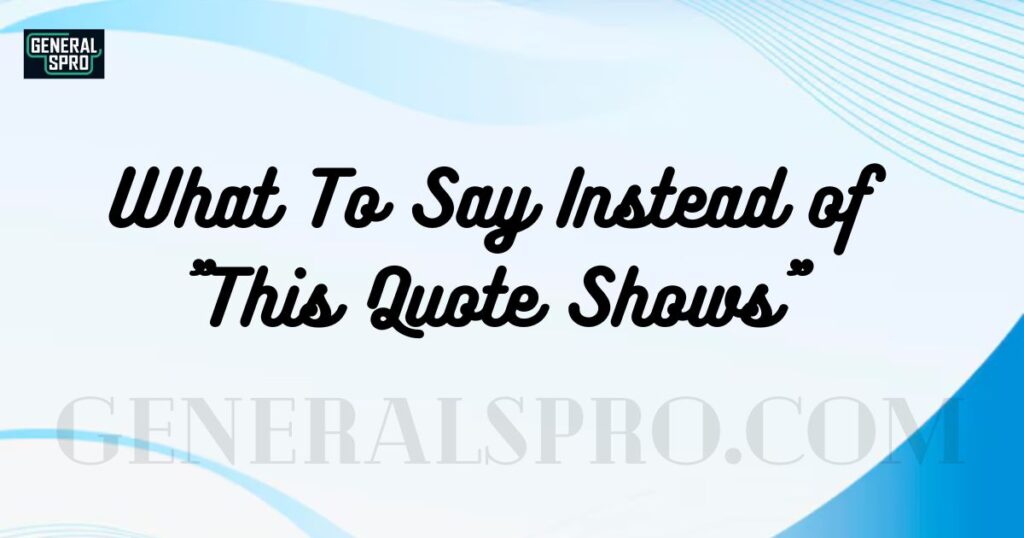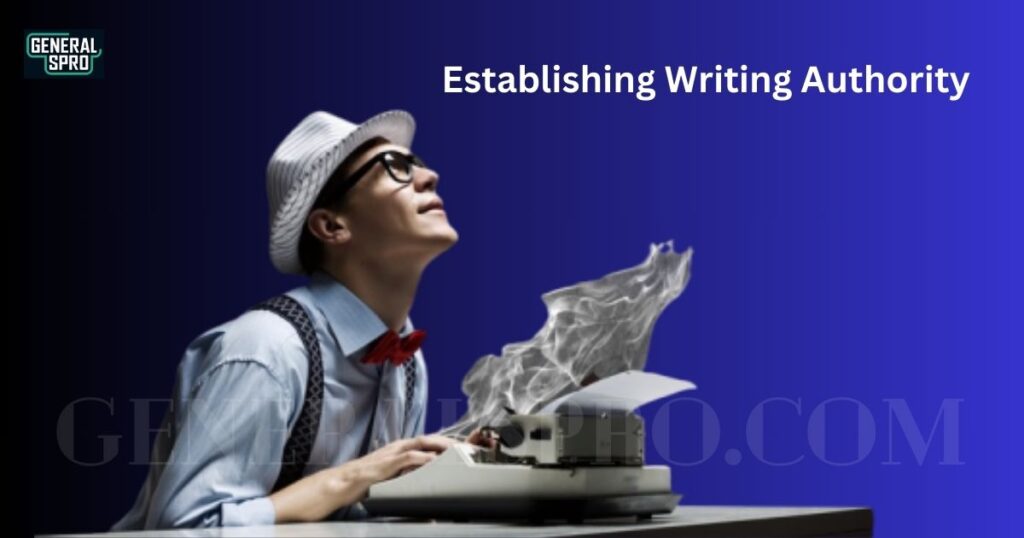Writing about textual evidence requires finesse and variety. Whether crafting an academic paper or analyzing literature, knowing different ways to introduce and explain quotes makes your writing more engaging and professional.
Let’s explore fifteen effective alternatives to the overused phrase “this quote shows,” complete with examples and practical applications.
What To Say Instead of “This Quote Shows”

When analyzing textual evidence, your choice of words can significantly impact how well you convey your interpretation. Here’s a detailed exploration of alternatives to enhance your writing’s sophistication and clarity.
This Quotation Illustrates
“This quotation illustrates” is an elegant way to introduce textual evidence in academic writing. It suggests a deeper connection between the quote and your analysis, which is particularly useful when explaining complex literary concepts.
For instance, when analyzing Shakespeare’s Macbeth, you might write: “This quotation illustrates the protagonist’s descent into paranoia: ‘Is this a dagger which I see before me?'”
This Excerpt Demonstrates
Using “this excerpt demonstrates” works exceptionally well when highlighting a specific aspect within a more extended passage. It’s particularly effective in research papers and literary analysis.
For example: “This excerpt demonstrates the author’s masterful use of metaphor to convey the complexity of human relationships.”
The Passage Reveals
“The passage reveals” offers a more dramatic introduction to your analysis, suggesting the uncovering of hidden meaning. It’s especially powerful when discussing subtle themes or underlying messages.
Consider: “The passage reveals the character’s internal struggle with identity, particularly evident in the phrase ‘I contain multitudes.'”
This Citation Highlights
When emphasizing key points in academic writing, “this citation highlights” provides a formal yet clear transition.
It works particularly well in research papers and scholarly articles. For instance: “This citation highlights the correlation between environmental factors and adolescent behavioral changes.”
These Words Underscore
“These words underscore” effectively emphasizes the importance of specific textual evidence. It’s beneficial when reinforcing your main argument. Example: “These words underscore the author’s criticism of social inequality: ‘The rich get richer while the poor get children.'”
Strengthening Analysis Through Word Choice
Introducing textual evidence significantly impacts our argument’s effectiveness in professional and academic writing. The phrase “this quote shows” often appears repetitive and elementary, potentially weakening otherwise strong analysis.
Expanding our vocabulary and choosing a precise language can create more compelling and sophisticated written work.
Understanding the Impact of Transitional Phrases
Transitional phrases bridge evidence and analysis, guiding readers through your reasoning. When selected thoughtfully, these phrases do more than connect ideas—they enhance comprehension and demonstrate analytical depth.
Strong transitions reflect clear thinking and help maintain reader engagement throughout your document.
Elevating Academic Writing Standards
Professional environments demand sophisticated communication skills. Analyzing and presenting evidence effectively sets exceptional writing apart from merely adequate work.
This skill becomes particularly crucial in research papers, business proposals, and academic assignments where precision matters.
Implementing Advanced Citation Techniques
Modern citation practices extend beyond basic quotation introduction. They require nuanced approaches that connect evidence to arguments while maintaining a professional tone and clarity. Understanding various ways to present evidence helps writers adapt to different contexts and audience expectations.
Mastering Evidence Integration
Seamless evidence integration marks the difference between novice and expert writing. Rather than merely inserting quotes, skilled writers create fluid connections between their ideas and supporting evidence. This integration requires a diverse vocabulary of transitional phrases and analytical expressions.
Developing Professional Writing Competency
Professional writing competency includes the ability to vary language while maintaining consistency in tone and style. This skill particularly matters when presenting multiple pieces of evidence within a single document or presentation.
Building Analytical Frameworks

Strong analytical frameworks rely on clear communication of relationships between evidence and conclusions. The phrases we choose to introduce evidence can strengthen or weaken these relationships, affecting our argument’s overall impact.
Enhancing Document Coherence
Document coherence depends partly on how smoothly we transition between ideas and evidence. Varied yet appropriate transitional phrases help maintain flow while demonstrating sophisticated thinking.
Crafting Persuasive Arguments
The art of persuasion often hinges on how effectively we present and explain evidence. Advanced transitional phrases help establish credibility and demonstrate thorough analysis of supporting materials.
Demonstrating Critical Thinking
Our choice of words when introducing evidence reflects our critical thinking abilities. More sophisticated alternatives to “this quote show” demonstrate deeper engagement with the material and stronger analytical skills.
Adapting to Different Writing Contexts
Different writing contexts require different approaches to evidence presentation. Understanding various alternatives allows writers to adapt their style appropriately for academic, professional, or technical audiences.
Maintaining Professional Standards
Professional writing standards continue evolving, but the need for clear, sophisticated analysis remains constant. Mastering various ways to present evidence helps maintain these standards across documents and contexts.
Improving Writing Clarity
Clear writing requires precise language. By expanding our repertoire of transitional phrases, we can more accurately convey how the evidence supports our arguments, leading to better understanding among readers.
Establishing Writing Authority

Authority in writing often comes from how confidently and effectively we present evidence. More sophisticated transitional phrases help establish this authority while maintaining professional credibility.
Advancing Communication Skills
Advanced communication skills include the ability to present evidence clearly and persuasively. Mastering various ways to introduce quotes and evidence represents a key aspect of professional development in any field requiring written communication.
FAQ’s
How do I choose the correct alternative phrase for my writing context?
When selecting alternative phrases, consider your audience and document type. Academic papers may require more formal options, while business writing allows for slightly more conversational alternatives.
When is it appropriate to use multiple alternatives in one document?
Using varied phrases throughout a document enhances readability and demonstrates vocabulary range. Aim to space different alternatives evenly throughout your writing while maintaining consistency in tone.
Can these alternatives be used in informal writing settings?
While primarily designed for formal writing, many alternatives can be adapted for less formal contexts. Just ensure the chosen phrase matches your overall writing style and audience expectations.
How do I maintain consistency while varying my transition phrases?
Select alternatives from the same formality level to maintain a consistent tone while using different phrases. This helps maintain professionalism while avoiding repetition.
What’s the best way to introduce direct quotes in academic papers?
For academic writing, use formal alternatives like “this quotation illustrates” or “this passage demonstrates.” These phrases convey analytical rigor while maintaining a scholarly tone.
Should I use different phrases for primary versus secondary sources?
Yes, consider using more authoritative phrases for primary sources and more interpretative phrases for secondary sources. This subtle distinction can strengthen your analysis.
How many different transition phrases should I use in one paper?
Aim to use 4-5 different transition phrases for a typical academic paper, rotating them naturally. This provides enough variety without appearing forced.
Can these alternatives improve my writing’s credibility?
Yes, using sophisticated alternatives to “this quote shows” demonstrates a command of academic language and analytical thinking, enhancing your writing’s credibility.
Conclusion
Mastering these alternatives to “this quote shows” will significantly enhance your writing’s sophistication and impact. By incorporating these varied phrases thoughtfully, you’ll create more engaging and professional academic work while maintaining clarity and precision in your analysis.
Remember that the key to practical quote analysis lies in choosing the correct introductory phrase and ensuring your explanation connects the evidence to your argument. Use these alternatives as tools to build stronger, more nuanced analytical writing.








